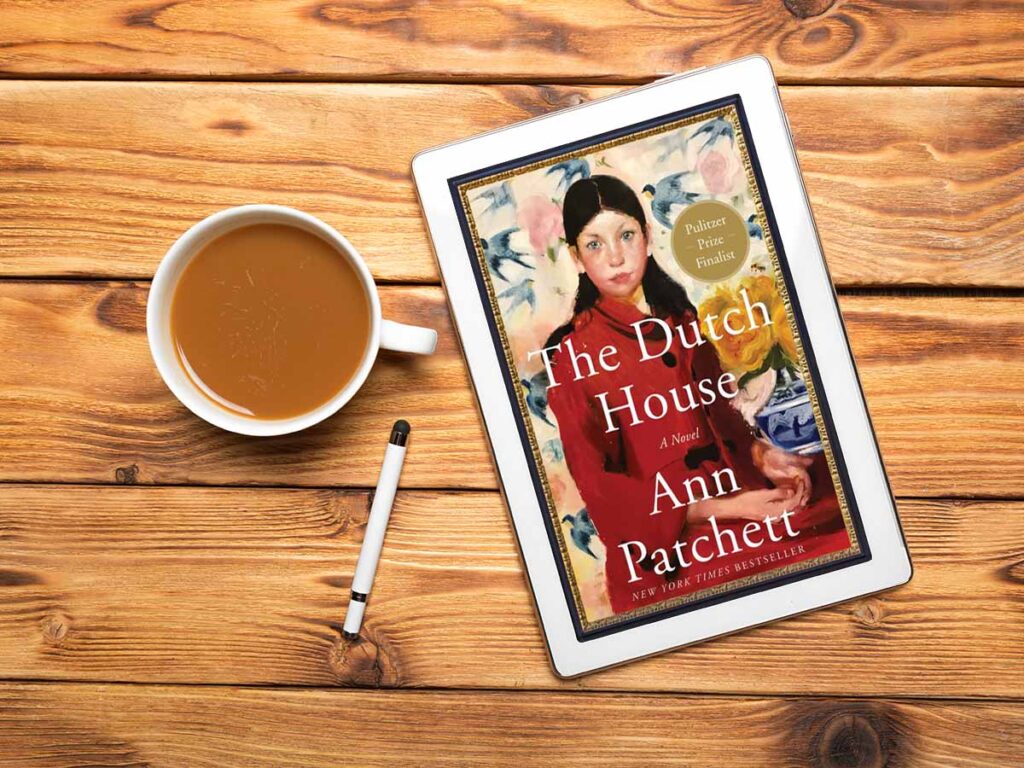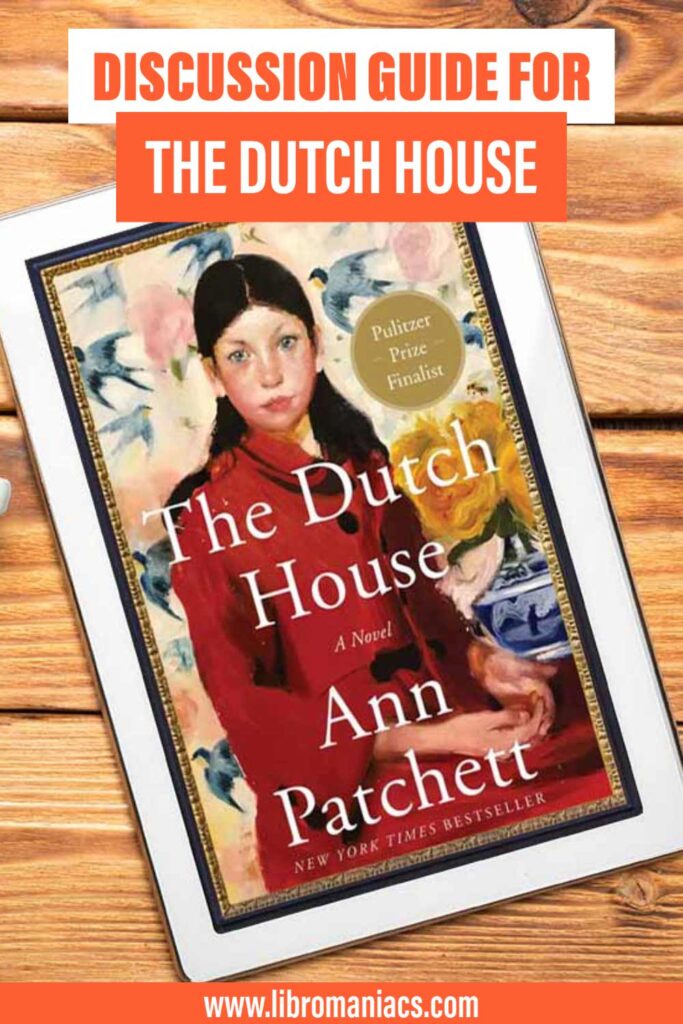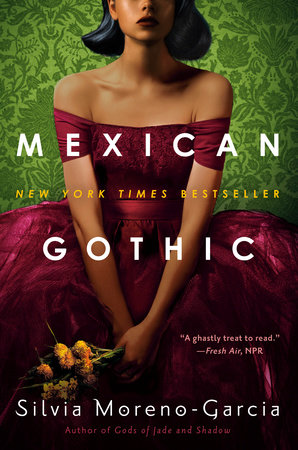Ann Patchett’s The Dutch House is quite a read. The novel has received a lot of accolades. It was a Pulitzer Award Finalist, Women’s Prize for Fiction finalist and it’s been featured on Jenna Bush’s Book Club list.
The Dutch House features a looming, ornate house that anchors a complicated multi-generational family story. The book’s themes feature abandonment, betrayal, damaging silences, revenge and a lot of sibling loyalty. And each character has their own relationship with the Dutch House, which adds a lot of layer to the narrative. This book is a great pick for a group read and we are here to help you unpack it with our The Dutch House book club questions and discussion guide.
Our usual format is to offer you the official publisher synopsis, 10 The Dutch House book club questions and some selected (and thought provoking) reviews. Start with the synopsis. Does it accurately reflect your experience with the book? Then move onto the questions and the reviews.
And if you loved the book, we also offer three more books like The Dutch House to help fill up your TBR list.

(This article contains affiliate links. This means that if you choose to purchase, I’ll make a small commission.)
The Dutch House Synopsis
The Dutch House, Ann Patchett
At the end of the Second World War, Cyril Conroy combines luck and a single canny investment to begin an enormous real estate empire, propelling his family from poverty to enormous wealth. His first order of business is to buy the Dutch House, a lavish estate in the suburbs outside of Philadelphia. Meant as a surprise for his wife, the house sets in motion the undoing of everyone he loves.
The story is told by Cyril’s son Danny, as he and his older sister, the brilliantly acerbic and self-assured Maeve, are exiled from the house where they grew up by their stepmother. The two wealthy siblings are thrown back into the poverty their parents had escaped from and find that all they have to count on is one another. It is this unshakeable bond between them that both saves their lives and thwarts their futures.
Set over the course of five decades, The Dutch House is a dark fairy tale about two smart people who cannot overcome their past. Despite every outward sign of success, Danny and Maeve are only truly comfortable when they’re together. Throughout their lives they return to the well-worn story of what they’ve lost with humor and rage. But when at last they’re forced to confront the people who left them behind, the relationship between an indulged brother and his ever-protective sister is finally tested.
The Dutch House Book Club Questions
- Why use a house for the main narrative metaphor? Did that work? Was the Dutch House a character in and of itself?
- “We always knew that my father didn’t like children” And yet Cyril embarked upon a second marriage with a woman who came with two of them. What was his motivation for marrying Andrea?
- How is it that Maeve and Danny seemed so out of the loop regarding their father’s courtship with Andrea? Is it simply that they were clueless kids? Or was their father deliberately keeping them out of the loop? Would things have gone better if Cyril had made more of an effort to build a relationship between Andrea and the kids?
- Danny says, “There would never been an end to all the things I wished I’d asked my father. After so many years I thought less about his unwillingness to disclose and more about how stupid I’d been not to try harder.” There is a lot that goes unspoken in the Conroy family– between Danny and his father, between Danny and Maeve, between Andrea and everyone and certainly between Elna and her kids. Why the distance? Are there a lot of unspoken spaces in your family?
- Late in the book, Maeve argues that men leave their families all the time and are hardly judged for it. And yet, Elna is judged harshly for her abandonment. Did you judge her? Were you satisfied with her explanations for why she left?
- Speaking of judgements. Did you judge Cyril for not taking more care in his estate planning? He knew that Andrea and the kids didn’t get along and yet, he put her in charge of everything. Is this simply the way things were done in the 70’s? Who did you judge more– Cyril more for his lack of planning or Andrea for cutting out Danny and Maeve?
- “The fact that I had never wanted to be a doctor was nothing more than a footnote to a story that interested no one.” Medical school wasn’t the only way to spend heavily on education. Danny easily could have bilked the trust by getting an MBA and a law degree at Harvard. Why then, did Patchett chose medical school? And how did Danny’s profound disinterest in medicine affect the story?
- “And so I made the decision to change. It might seem like change was impossible, given my nature and my age, but I understood exactly what there was to lose. It was chemistry all over again. The point wasn’t whether or not I liked it. The point was it had to be done.” Danny says this after finally deciding to accept his mother’s return. What explains the very different reactions that Maeve and Danny have to her re-insertion into their lives?
- “We had made a fetish out of our misfortune, fallen in love with it.” Maeve and Danny spent so many nights talking, smoking and lurking in front of the Dutch House. Were they too obsessed? Or did the time they spent together help them stay bonded as siblings?
- Elna had felt suffocated by the Dutch House, and yet in the end, she moves back in to care for Andrea and reprises Fluffy’s former role as the caretaker. Why was she able to finally tolerate the house after so many decades of being away from it?
Selected Reviews for The Dutch House
“Just punch me right in the heart next time, Patchett. It’d be faster.”
“In terms of scope, tone, setting, and depth, this book seems like a throwback to masterpieces written in the 1700s and 1800s; there is a classic and epic feel to it. Having a grand mansion as the setting helps. As in classics, Patchett does give lots of details of things that by themselves aren’t interesting, but she ends up painting a vivid picture that sets a perfect stage for the action going down, and you feel like you’re right there.”
“A little like a fairy tale flipped upside-down, this story includes an imposing, castle-like house, which seems to affect each character differently, as though abiding inside these walls seems to create an entirely different relationship between the house and each character.”
“This was an absorbing read even though the narrator was infuriating, self-absorbed, oblivious, selfish, and annoying…There is an epic feel to this novel but it is also an intimate portrait of siblings who have found home in each other when they are failed by the adults who were supposed to nurture them.”
“The writing is still compelling enough that it helped carry the story through to the end, so I was never bored. But the last two thirds shambled along without momentum or purpose, and was utterly forgettable. It feels like I read a short story that reached its conclusion and then continued on for 200 more meandering pages.”
3 Books like The Dutch House
If you like the pics for Jenna’s Book club, then be sure to check out our reading guide for The Lincoln Highway, Black Cake, The Measure, Remarkably Bright Creatures and Malibu Rising. Or if you group like pulitzer award winners, then you could also get our guide for The Night Watchman by Louise Erdrich or All the Light We Cannot See by Anthony Doerr.
We also recommend taking a look at Patchett’s newer book Tom Lake. You can get more info (+ a synopsis) on our Tom Lake discussion guide.
The Nest
by Cynthia D’Aprix Sweeney
When doped-up Leo Plumb crashes his car and severely injures a women, he needs some fast cash to get him out of the pickle. And the money is there– but it’s always been intended as a bequest for all four of the Plumb siblings, who each have their own issues. The Nest explores what money does to relationships, what happens to our ambitions over the course of our lives, and the fraught but unbreakable ties we have with our families.
The Nest cues on the same Dutch House themes as the corruptibility of money and sibling loyalty (and disloyalty). Also, a lot of the action takes place in NYC.
The Wangs Vs the World
by Jade Chang
This first generation Chinese immigrant family had it all…until they didn’t. Charles the dad is reluctant to tell his kids how bad it really is. And yet, he spirits the family away on a countrywide road trip in an effort to make a fresh start. His wife wants their old life back, his son wants to be a comedian, his younger daughter is obsessed with fashion and their oldest daughter is hiding out from all of them.
The book has more overt humor than The Dutch House, but it picks up the themes of fraught family relationships, stepmoms, and resiliency.
Mexican Gothic
by Silvia Moreno-Garcia
If you like the idea of a large old house as a major character in a book, then take a look at Mexican Gothic. When Noemí Taboada gets a frantic SOS letter from her cousin, she heads to High Place, a distant house in the Mexican countryside to see what’s up. This truly gothic read is fraught with dark family secrets, fading family wealth and a brooding (and perhaps dangerous) house.
It’s more atmospheric than The Dutch House and it may give you the shivers.
Have a listen on Audible. Try audio books for free for 30 days.
Share our The Dutch House discussion guide on Pinterest:





